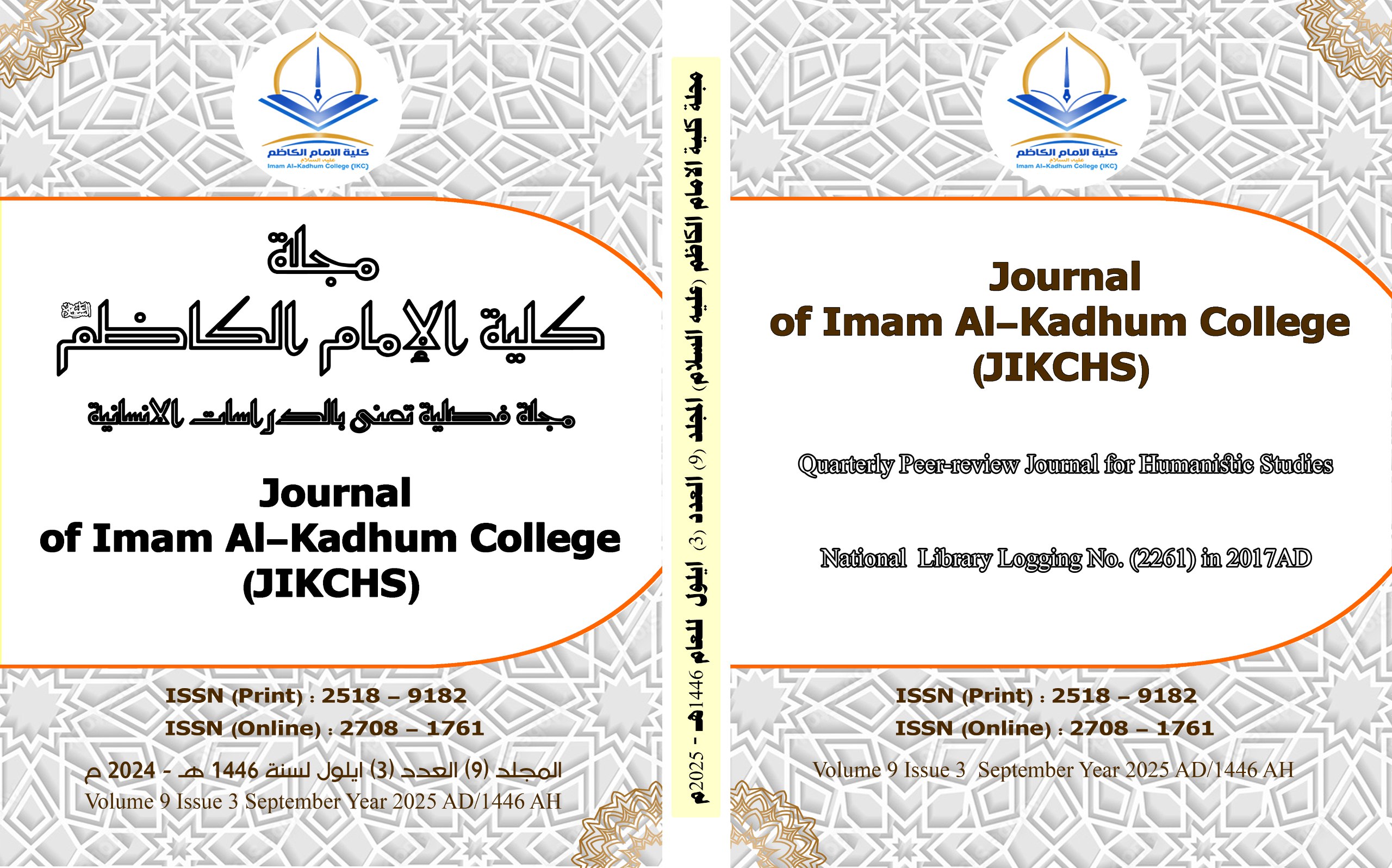The effectiveness of artificial intelligence in verifying the content of television advertisements
DOI:
https://doi.org/10.61710/e38kpj69Keywords:
Deep fake, Artificial Intelligence, Television Advertising, Content Analysis, Digital Marketing, Deepfake, Artificial Intelligence, Television Advertising, Content Verification , Detection TechniquesAbstract
The research aims to analyze the content of television advertisements that used deepfake technology and explore the effectiveness of artificial intelligence techniques in the advertising industry. A sample of seven prominent television advertisements was selected according to specific scientific criteria to understand how this technology is employed in visual narratives, enhance advertising impact, and engage with audiences. The research relied on a content analysis approach, using analytical tools to explore the visual, linguistic, and narrative elements in these advertisements. The results showed that deepfake technology contributes to the creativity and attractiveness of advertisements, but at the same time, it raises challenges related to media ethics and content reliability. The research recommends the development of clear regulatory standards for the use of deepfake in advertising, raising public awareness about this technology, and conducting future studies on its long-term impact on consumer behavior and media culture.
References
المصادر العربية و المترجمة للعربية:
ابوزيد, ا. (2019). الاتجاهات الحديثة في بحوث ودراسات استخدامات الذكاء الاصطناعي في الصحافة. Journalism department, Mass Communication faculty, 116. doi:https://doi.org/10.21608/jmis.2022.266266
الباز, خ. (2022). الإعلان الرقمي في عصر البيانات الضخمة. القاهرة: دار الفكر للنشر و التوزيع.
الراشد, ن. ع. (2024). تأثير الذكاء الاصطناعي على مستقبل الإعلام. الكويت: المجلة الدولية للبحوث العلمية.
أوسوندي, أ. أ., & ويلسر, و. (2022). مخاطر الذكاء الاصطناعي على الأمن و مستقبل العمل. Washington: Rand Corporation.
سامي, ه. (2020). تقنيات الإعلام الحديثة والمحتوى المزيف. دبي: دار النشر الحديثة.
سعد, ع. (2019). التطبيقات العملية للذكاء الاصطناعي في الكشف عن التزييف العميق. مجلة علوم الكمبيوتر, 24(2), 151.
عقوني, م. (2023). التسويق و الإعلام الرقمي. Retrieved from التربية الرقمية: kotobati.com
مركز الإمارات, ل. و. (2024). تحديات التزييف العميق لمصداقية المعلوماتوسبل مواجهتها. أبو ظبي: مركز الإمارات للدراسات و البحوث الاستراتيجية. Retrieved from https://www.ecssr.ae/ar/research-products/reports/2/197320?utm_source=chatgpt.com
معوض, أ. م. (2022). استخدامات الذّكـاء الاصطـناعي(AI) استخدام تقنية التزيِيف العميق Deepfake)) في قذف الغير نموذجًا دراسة فقهية مقارنة معاصرة. مجلة البحوث الفقهية و القانونية, 34(39), 2516. doi:https://doi.org/10.21608/jlr.2022.163670.1114
المصادر الأجنبية:
Anderson, M. (2022). Deepfake Marketing and Ethical Dilemmas in Advertising. Oxford: Oxford University Press.
Brown, D. (2021). The Role of Analytical Approaches in Media Research. New York: Routledge.
Chaffey, D. (2020). Digital Marketing: Strategy, Implementation, and Practice. Harlow, Essex, United Kingdom: Pearson Education.
Chesney, R., & Citron, D. (2019). Deepfakes and the Threat to Truth in Media. Berkeley: California Law Review.
Fellman, S. (2023). Russian TV Airs Apparent Deepfake Video of Putin Ordering Martial Law amid Reports Ukraine Is on the Attack. moscow.
Hamdan, A., & Aldhaen, E. S. (2024). Artificial Intelligence and Transforming Digital Marketing. Berlin: Springer.
Jarek, K., & Mazurek, G. (2019). Marketing and Artificial Intelligence. Central European Business Review, 8(2), 48. doi:10.18267/j.cebr.213
Johnson, M. (2019). Deepfake Detection: Advances and Implications for Media Integrity. Cambridge: Cambridge University Press.
Jones, P., & Williams, S. (2021). Big Data and Consumer Behavior in Digital Advertising. New York: Palgrave Macmillan.
Kotler, P., Kartajaya, H., & Setiawan, I. (2021). Marketing 5.0: Technology for Humanity. Wiley: New Jersey.
LeCun, Y., Hinton, G., & Bengio, Y. (2020). Deep Learning. Nature, 521(7553), 437. doi:10.1038/nature14539
Marcel, S., & Korshunov, P. (2018). DeepFakes: a New Threat to Face Recognition? Assessment and Detection. arXiv.
Nguyen, T., Li, W., & Zhao, M. (2023). Adversarial Advances in Deepfake Creation and Detection. Journal of AI Security, 12(1), 71.
Rössler, A., Cozzolino, D., Verdoliva, L., & Riess, C. (2022). Face Forensics: Analyzing the Evolution of Deepfake Manipulation. IEEE Transactions on Information Forensics and Security, 17(3), 155.
Smith, J. (2020). Artificial Intelligence in Media: Challenges and Innovations. Berlin: Springer.
Smith, L. (2022). Technology-Driven Marketing Strategies: The Future of Advertising. New York: Routledge.
Tang, Y. (2020). Augmented Reality Advertising and Consumer Engagement. Berlin: Springer.
Thing, V. L. (2021). Deepfake Detection with Deep Learning: Convolutional Neural Networks versus Transformers. IEEE Xplore, 418. doi:https://doi.org/10.1109/CSR57506.2023.10225004
Thomas, H. D., Erik, B., Andrew, M., & James, W. (2019). Artificial Intelligence: The Insights You Need from Harvard Business Review. Harvard: Harvard Business Publishing.
Verdoliva, L. (2023). Media Forensics: Recent Advances and Challenges in Deepfake Detection. Annual Review of Computer Science, 48(1), 99.
Verma, P. (2023). The Rise of AI Fake News Is Creating a ‘Misinformation Superspreader’. Washington : The Washington Post.
Williams, E. (2018). Technological Tools in Media: A Descriptive Approach. Oxford: Oxford University Press.
Zhao , D., Jun , L., & Tianjiao, W. (2022). Augmented Reality Marketing: A Systematic Literature Review
Downloads
Published
Issue
Section
License
Copyright (c) 2025 Journal of Imam Al-Kadhim College

This work is licensed under a Creative Commons Attribution-NonCommercial-NoDerivatives 4.0 International License.




